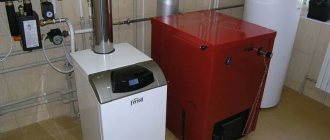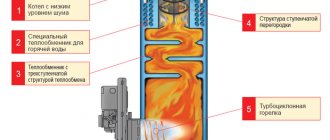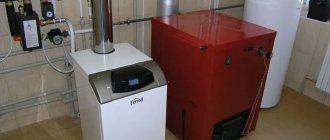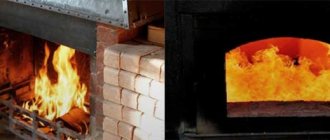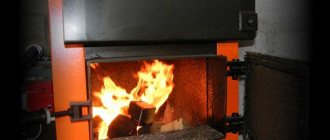14.09.2021 13:52
Heating oil is a petroleum product that is produced from diesel fractions of secondary distillation. It has good fluidity and a low freezing point, and is an inexpensive analogue of diesel fuel.
Due to minor differences from diesel fuel, heating oil is often purchased wholesale and retail for heating boilers. The serviceability and efficiency of expensive heating equipment directly depends on its quality. Therefore, we will consider in detail the characteristics of these petroleum products and find out what fuel can be used for heating boilers.
General characteristics
Boilers that run on diesel fuel are used both in industrial boiler houses and in domestic installations. Domestic boilers can operate on the following energy sources:
- diesel is the highest quality and most expensive fuel. Operating costs when using it are the same as when using gas and electricity, and in some cases even higher;
- stove - similar in characteristics to diesel fuel, but produced from heavier fractions of oil. Its calorific value is 15–20% lower, but the price is almost 2 times lower. Heating oil requires more thorough filtration than diesel.
Heating oil includes various impurities and compounds. It is based on hydrocarbons:
- paraffins;
- mothballs;
- cycloparaffins;
- alkylbenzenes;
- indens;
- acenaphthenes;
- acenaphthylene.
Heating boilers are complex and expensive devices. Therefore, their manufacturers must indicate in the passport the characteristics of the fuel used. The cleaner it is, the more efficiently the equipment operates and the combustion is more efficient.
How to calculate how much solid fuel you need to have in stock?
Of course, any owner of a solid fuel heating unit would like to know how much firewood (briquettes, coal) he will need to survive the winter season without any problems. This can be calculated, approximate, of course, but on the scale of a “heating company” it is still quite reliable.
To simplify the task for the reader, we will not give formulas - we will simply invite him to use the capabilities of an online calculator, which already contains the necessary calculation algorithm. And below the calculator the necessary explanations for performing the calculation will be given.
Calculator for calculating the average consumption of solid fuel for heating
Go to calculations
Explanations for performing calculations
- The starting value for the calculations is the thermal power formula that needs to be spent to fully heat the house. An important nuance is that this is not the maximum thermal power of the stove or boiler specified in the passport, since it is usually overestimated - the model is purchased with a very significant operating reserve.
But we are interested precisely in the amount of thermal energy that is required by the specifics of the heated premises and the entire house as a whole. We will not repeat how to determine it, since this is described in great detail in a special publication on our portal.
You may be interested in information about what a buffer tank for a solid fuel boiler is
How to determine the heat requirement for the premises of a house or apartment?
The reader is presented with an algorithm that takes into account not only the area of the premises, but also a host of other specific factors that, to a greater or lesser extent, influence the heating power. can do this step-by-step heating calculation using a special article that describes and justifies each action in detail.
- Any solid fuel heating unit loses some of the heat generated. These losses are characterized by the efficiency factor, which must be indicated in the device passport.
- Next, you should choose the direction of calculation - whether it is carried out for firewood or for other types of solid fuel. Depending on the selected path, additional data entry fields open.
— If firewood is selected, then the type of wood is selected from the drop-down list, and then the degree of drying of the firewood is indicated.
— If you select other types of fuel, a list box will open - select the desired option.
- After clicking on the calculation button, the desired result will appear. For convenience, it is shown for daily, weekly and monthly consumption.
A small nuance: if you chose the calculation for firewood, then the units of measurement for the shown value are cubic meters. For all other types of solid fuel, the result is in tons. The calculator provides appropriate tips.
It should be correctly understood that the accuracy of such calculations still suffers quite a lot. The reason is simple - the calculation is carried out for the most unfavorable conditions. Meanwhile, severe cold usually does not last so long; most of the winter the frosts are moderate, and are often replaced by thaws. That is, in any case, the consumption should be somewhat lower.
It's okay - stock is always useful, anything can happen. Well, after a couple of years of operation, the owners will no longer need any calculations at all - they will know perfectly well what kind and how much fuel they need to prepare for the season.
* * * * * * *
Let’s finish the article with an interesting video that compares the advantages and disadvantages of firewood and fuel briquettes. Read about tall bimetallic radiators on the website.
Features of household heating oil
There are no strict standards regulating the manufacturing technology of heating oil, its composition and properties. At the same time, manufacturers are constantly improving it, trying to achieve maximum similarity with a diesel engine.
Heating oil does not have a specific odor that occurs during the combustion of other petroleum products. An important characteristic is the low freezing point, which reaches -28 °C. All these qualities expand the possibilities of using energy.
Heating oil contains more sulfur compounds than diesel fuel. According to their content, PT is divided into 2 types:
- low sulfur - less than 0.5%;
- sulfur - less than 1.1%.
Sulfur is a negative impurity for hydrocarbon products, including heating oil. During the combustion process, it is converted into sulfurous acid, which corrodes the inner surface of boilers and chimneys. Also, its excessive content contributes to the formation of a harmful compound - sulfur dioxide. Consequently, fuel with a lower percentage of sulfur is more suitable for heating equipment.
What is diesel fuel?
Diesel fuel, like heating oil, belongs to the group of petroleum products and consists of the same hydrocarbons. It is obtained by distillation and selection from a certain type of fraction.
Types of diesel fuel Lukoil and Gazprom
Its characteristics are decent:
- Density. This indicator is responsible for the volume of fuel in the generator. With sufficient density, more thermal energy is released.
- Pour point. Not lower than 6 degrees than the ambient temperature.
- Cetane number. An indicator that allows you to highlight data on the ignition delay period of the composition. The larger it is, the more measured and smoothly the diesel fuel burns.
- Viscosity. If the norm is exceeded, fuel atomization will be performed poorly, and this is fraught with early abrasion of parts and frequent breakdowns of mechanisms.
- Sulfur percentage. Sulfur is an important component of diesel fuel. It smells unpleasant due to many toxins, which - alas! - there's no escape. The more sulfur, the more prone the fuel is to detonation, the more tar is released during the cracking process, and the greater the corrosive activity.
- Flammability. Diesel fuel is a non-volatile petroleum product, i.e. the flash point is over 60 degrees.
- Corrosion resistance. A copper plate is used for testing. During the experiment, it is lowered into a container filled with diesel fuel, and after a few hours, experts take it out and evaluate the results.
- The amount of sediment and water in the fuel. The acceptable percentage is very small: no more than 1%.
There are several classifications of diesel fuel:
- Firstly , by the amount of sulfur: the first (up to 350 mg/kg), the second (up to 50 mg/kg) and the third (up to 10 mg/kg) type.
- Secondly , there is summer, winter and arctic diesel fuel. Summer is obtained by distillation. This option is used from April to November (the air temperature should not be below 5 degrees, otherwise the liquid becomes very cloudy and loses quality). Experts advise draining summer diesel fuel in advance - before the onset of the first cold weather. Winter fuel has a lower content of paraffin-forming hydrocarbons and wider viscosity parameters. In central Russia it is used more often and longer. Arctic is popular in regions with permafrost, as well as where air temperatures often drop below 30 degrees. Its viscosity is from 1.45 to 4.6 sq. mm/s, density is 760-820 kg/m3.
REFERENCE! Summer diesel fuel is cheaper than the rest, winter diesel fuel is 20% more expensive than summer diesel fuel, and Arctic diesel fuel is 30-40% more expensive than winter diesel fuel.
Improper use of diesel fuel leads to the formation of paraffin crystals in it, which clog the fuel filter and safety nets, and accumulate in the heat pipe. The fuel pump of the internal combustion engine gradually stops functioning and the engine is damaged.
Differences from diesel fuel
Household heating oil is produced according to specifications, and not according to GOST. This means that each manufacturer has the right to establish independent quality characteristics of the product it produces. These figures are certainly worse than those of diesel. Therefore, when using fuel, it is worth considering the characteristics specified by a specific manufacturer.
| Product Feature | Heating oil | Diesel fuel |
| Raw materials for production | Diesel fractions of secondary origin | Oil |
| Factional composition | 10% is distilled at temperatures above 160 °C; 90% - at 360 °C | 50% - at a temperature of at least 280 °C; 95% - at a temperature of no more than 360 °C |
| Ultimate filterability temperature | -5 °C | -10 °C for summer fuel. Off-season and winter thicken at lower temperatures |
Heating oil is produced through secondary distillation of diesel fractions. The fractional composition of such an energy carrier differs from standard diesel fuel. PT is slightly heavier than diesel and is also characterized by increased viscosity. Since it is produced according to specifications with more strict requirements for the cetane number and the content of sulfur compounds, we can talk about lower quality compared to diesel fuel.
What is the difference in relation to heating boilers?
When using heating oil, it should be taken into account that the requirements of domestic and foreign boiler manufacturers are not the same. For comparison, we will focus on European standards regarding the characteristics of liquid fuel according to EL DIN 51603 standards, which are provided for heating boilers:
- density at 20 °C - 820 - 860 kg/m3;
- viscosity - 6 mm2/s;
- sulfur concentration - 0.005%;
- coking rate - 0.3%;
- ash content - not higher than 0.01%.
To compare heating oil and diesel fuel, it is worth citing the characteristics that are important for use in diesel boilers.
| Product Feature | Heating oil | Diesel fuel |
| Sulfur concentration | 0,5 – 1,1 % | 0,05 % |
| Residue carbonization 10% | up to 0.35% | up to 0.2% |
| Mass fraction of ash | up to 0.2% | up to 0.01% |
Increased viscosity does not greatly affect the functioning of heating equipment. The most significant characteristics are considered to be coking properties and ash content. It is these that the buyer is recommended to pay attention to first. These values indicate the intensity of soot formation on the inner surface of the boiler and chimney. Experiments have demonstrated that a soot layer just 0.01 cm thick reduces boiler efficiency by 4%. When the layer thickness increases by 2 times, the efficiency decreases by 8%.
As for density, cetane and iodine numbers, which are the main characteristics for any fuel, in this case they are not standardized.
Considering all of the above, it can be argued that diesel is better suited for heating boilers than PT. The only advantage of heating oil is the cost; it is 30% cheaper. This difference will allow you to save a large amount, part of which can be spent on maintenance and cleaning of the boiler.
Oil burners for boilers
| Oil burners |
Combined gas-diesel fuel and gas-fuel oil burners are more expensive than specialized liquid fuel burners, but can provide uninterrupted heat supply when changing the type of fuel, for example, when a house is gasified over time. Such burners require adjustment separately for each type of fuel; they have a device, mechanical or electronic, that regulates the air-fuel ratio in the supply mixture, and fuel oil-gas burners provide a fuel oil heater.
Actually, liquid fuel burners are divided into:
— burners with spray nozzles, including steam-mechanical nozzles;
— rotary type burners.
Rotary-type burners are insensitive to the quality of the fuel; in them, it is supplied with a small pressure, from 1 to 3.5 atm, onto a glass rotating at a speed of 5000 rpm. Even the presence of foreign particles in fuel oil does not lead to equipment failure in this type of burner. They are most often used at thermal power facilities.
| Diesel burner |
Burners with atomizing nozzles can be one-, two-, or three-stage, as well as modulating. Step regulation involves operating in one specified power range or switching during operation when the specified coolant temperature is reached to the next range.
The most economical are modulating burners, which smoothly change power from 10 to 100% using mechanical, pneumatic or electronic modulation. Fuel savings with proper configuration of this type of burner can be 5-15%. The cost of such burners is higher than that of step burners, but they will reduce the load on the mechanical parts of the boiler due to frequent switching on/off, increasing its efficiency and operating time in general.
Burner manufacturers often produce unified models suitable for different brands of boilers, and a heating equipment dealership consultant can recommend a suitable one from the available range.
Types of heating oil
There are 2 types of heating oil: light and dark. They differ in viscosity, combustion temperature and impurity content.
In light heating oil the concentration of impurities is lower, it has increased heat transfer, so it is widely used for diesel boilers. Dark is not suitable for use in modern boilers, usually used in equipment with pre-evaporation.
Each type of heating oil has its own advantages:
- light - used for operating large generators. It has increased heat transfer, which makes it possible to avoid expensive diesel when heating large residential premises;
- dark - has a high calorie content, due to this it is characterized by low consumption. Typically used for domestic needs, heating small buildings or utility rooms. Can be used in small power plants.
Liquid fuel boiler
Liquid fuel boilers can be made of cast iron or steel, and in the first case the service life will be about 50 years, and in the second - no more than 10. Standard high-temperature diesel boilers have combustion chambers located horizontally relative to the installed burner, while condensation boilers, which use the heat of combustion of water vapor, have vertical combustion chambers.
| Condenser diesel boiler | Standard high temperature diesel boiler |
Factory-installed mono- or multi-fuel burners can be subsequently replaced if the boiler fuel changes. In its design, a diesel boiler is not much different from a gas boiler, only the burners used are different. Diesel boilers with a permanent burner are cheaper and lighter in weight.
It is up to the owner to decide whether to choose a single- or double-circuit boiler, but since the need for heating the heating circuit far exceeds the need for hot water for domestic needs, it is cheaper to install a single-circuit boiler and a separate boiler.
Liquid fuel boilers are produced by many manufacturers of heating equipment, both domestic and foreign, for example, Buderus, Kiturami, Protherm, and it is worth remembering that liquid fuel boilers, like their burners, will require regular maintenance, cleaning from soot and scale, and these processes are best left to a specialist , so it is recommended to give preference to manufacturers who support their service department in the area where the boiler is installed.
Methods of obtaining
Heating oil is made from diesel fractions of secondary origin, which are formed during the oil refining process. The technology has low manufacturing costs, since the raw materials are low in price.
About 10% of the fuel is distilled at a temperature of at least 160 °C, 90% at 360 °C. Waste oil may be used during the manufacturing process. It undergoes minimal processing because it already has the necessary properties.
Advantages and disadvantages
Heating oil is used in industrial heating installations and stationary steam boilers. The main purpose is heating of private houses, industrial facilities and agricultural enterprises.
The main reason for using household heating oil instead of diesel is the lower price with similar characteristics. Inexpensive raw materials are used in production, and the finished product has a different taxation. Diesel fuel is expensive because its price includes transport tax.
Additional advantages of PT:
- • good fluidity;
- • economical consumption;
- • high calorific value and efficiency;
- • the ability to reduce the pour point using additives.
- The disadvantages of heating oil include the following:
- • higher amount of sulfur than in diesel;
- • production in accordance with technical specifications, and not GOST (there are no standard values of parameters that manufacturers must adhere to);
- • higher temperature of ultimate filterability.
Experts predict that, due to its characteristics, heating oil will gradually take a leading place in the market and replace traditional types of fuel.
Areas of use and storage
As has already become clear, heating oil has a relatively wide range of applications . Its main purpose is to use it in the heating system of private houses and industrial sites where small and medium-sized heating installations are used. Heating oil is often used in dachas and country houses where it is impossible to install a gas pipeline. There is also demand for heating oil among small boiler houses and agricultural enterprises. For example, there is a constantly growing portion of granaries, vegetable warehouses and livestock pens that are heated in exactly this way.
Today in our country there are many companies and enterprises that are engaged in the production and sale of various brands of heating oil.
Today, in almost any city you can choose one or another option for yourself. After purchase, it must be stored under certain conditions : away from ultraviolet radiation, at average humidity.
It also needs to be protected from extremely low and high temperatures. This will preserve the key properties that will be needed for high-quality heating of residential premises and outbuildings. with transportation , as well as with storage. Typically, heating oil is transported in tank trucks, fuel trucks and even barrels using rail or road transport. Tanks must have a hole at the bottom for easy drainage of fuel, as well as a pressure control system so as not to compromise safety. If you need to transport a small amount of fuel, you can even use cans, but they must be made of metal or polymer materials. By the way, during transportation it is recommended not to fill the container completely, leaving approximately 5% of the total volume free.
Is it possible to use heating oil for boilers?
In terms of its characteristics, heating oil is in many ways similar to diesel, but has a number of important differences. PT is produced in accordance with specifications, which are different at each enterprise. This means that less stringent requirements are imposed on the main parameters: cetane and iodine number, cloud point, amount of sulfur, ash mass fraction and viscosity.
Many enterprises strive to approach high standards by producing high-quality petroleum products that best match the properties of diesel fuel. Therefore, heating oil can be used for diesel boilers, taking into account the characteristics of their operation and maintenance.
Bibliography:
- Dotsenko S. P., Tretyakova O. I., Gubanova N. Ya., Korzh I. A., Research and development of composite stove fuel [Electronic resource] - URL: https://cyberleninka.ru/article/n/perspektivy -ispolzovaniya-nefteshlamov-v-sostave-toplivnyh-kompozitsiy/viewer
- Zlobin V. G., Zverev L. O., Increasing the efficiency of liquid fuel boiler plants [Electronic resource] - URL: https://cyberleninka.ru/article/n/povyshenie-effektivnosti-kotelnyh-ustanovok-na-zhidkom- fuel/viewer
- Shrubok A. O., Grushova E. I., Yusevich A. I., Timoshkina M. A., Trukhanovich E. V., Prospects for the use of oil sludge in fuel compositions [Electronic resource] - URL: https://cyberleninka. ru/article/n/metod-parofaznogo-gazohromatograficheskogo-analiza-svetlyh-nefteproduktov/viewer
Liquid fuel storage tanks
| Liquid fuel storage tanks |
First of all, let us clarify that according to SNiP, the installation of tanks for storing liquid fuel is prohibited in roof-top boiler rooms and basements.
Currently, tanks are made of steel, aluminum, stainless and enameled steel, and plastic. Made from any material, the container must be durable and airtight, because liquid fuel for the most part is a flammable material and its leakage is dangerous both as a cause for a fire hazard and in terms of environmental pollution.
Tanks differ in above-ground, underground or semi-underground installation and can have a volume from 500 to 20,000 liters. It is possible to connect several tanks to maintain the required supply, but for a separate boiler room the supply should not exceed 150 m³ according to the norm. Tanks made of polypropylene with a volume of up to 5 m³ can be installed directly in the boiler room, separating the tank with a blank wall. In the immediate vicinity of the boiler, only a reserve tank with a volume of no more than 800 liters can be placed at a distance of at least 1 m from the burner.
The shelf life of fuel does not exceed a year and it is more reasonable and profitable to have a supply of it for one heating season. You should calculate the possible consumption for heating the house, select a container of the appropriate size and deliver the fuel at one time, saving on delivery.
Most often today, containers made of polymer materials are used. They are lightweight, not subject to corrosion, can withstand temperatures from -50 degrees C to +50 degrees C, and using fixing packages you can conveniently insert pipelines. The bottleneck of polymer tanks is strength, so in EU countries for containers over 1000 liters. there is a requirement that they be double-walled, but in Russia this is still only a recommendation.
| Diesel fuel storage |
If the container is supposed to be above ground, they often choose it from polymer materials and pay attention to the shape - vertical rectangular tanks that can fit through a doorway are more convenient. Cylindrical tanks are cheaper and they are more often used for large volumes of fuel, over 5 m³; they can be installed in a large room above ground or underground. The distance from the boiler room to the tank must be at least 9 m. Indoor tanks are installed inside a fireproof frame.
Underground fuel storage facilities are safer in a horizontal design; they are equipped with two hatches - for draining fuel and an inspection hatch.
When installing a container outdoors, a fuel pump is required to supply liquid through fuel lines under pressure to the inlet of the burner; in some burner models, the pump is already included in the package.
All fuel tanks have a hole at the bottom to drain the thickening residue; a contaminant filter must be installed at the place where the fuel is drained. For convenience, you can install a fuel level sensor, mechanical or electronic, and, if necessary, a certified fuel heater.
| Photo of a working diesel boiler |
Additional fuel heating is carried out in the burner.
